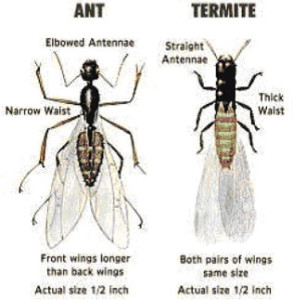Termites seem to come out of the woodwork every spring… but could they actually be coming in and infesting your home? Learn more about these costly pests and their life cycle.
Understanding the Termite Life Cycle
When you think of spring, you probably envision blooming flowers and the return of warmer weather. But in the pest control industry, spring marks the beginning of peak pest season, when most insects are coming out of their winter hiding spots, mating – and in some cases – finding their way into our homes. Unfortunately,
Continue reading
 Discovering winged termites indoors usually indicates a termite infestation. But don’t confuse winged termites with ants, which often swarm at the same time of year. Termites can be differentiated by their straight antennae, uniform waist and wings of equal size. (Ants have elbowed antennae, constricted waists and forewings that are longer than the hind wings.)
Discovering winged termites indoors usually indicates a termite infestation. But don’t confuse winged termites with ants, which often swarm at the same time of year. Termites can be differentiated by their straight antennae, uniform waist and wings of equal size. (Ants have elbowed antennae, constricted waists and forewings that are longer than the hind wings.)
The swarmers are attracted to light and are often seen around windows and doors. Termite swarmers emerging from tree stumps, woodpiles, and other locations out in the yard are not necessarily cause for concern, and do not necessarily mean that the house is infested. On the other hand, if winged termites are seen emerging from the base of a foundation wall or adjoining porches and patios, there’s a good chance the house is infested also and treatment may be warranted.
 Other signs of infestation are earthen (mud) tubes extending over foundation walls, support piers, sill plates, floor joists, etc. The mud tubes are typically about the diameter of a pencil, but sometimes can be thicker.
Other signs of infestation are earthen (mud) tubes extending over foundation walls, support piers, sill plates, floor joists, etc. The mud tubes are typically about the diameter of a pencil, but sometimes can be thicker.
Termites construct these tubes for shelter as they travel between their underground colonies and the structure. To help determine if an infestation is active, the tubes may be broken open and checked for the presence of small, creamy-white worker termites.






































































